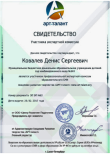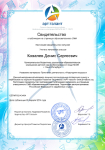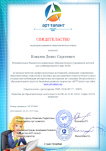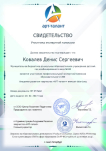Karina A.Asadullina,
3rd year student of the specialty psychology of service activity, faculty of Psychology, National Research University "BelSU", Russia, Belgorod
scientific adviser - Alexander V. Markov
senior lecturer Foreign languages department NRU BSU
RELATIONSHIP OF COMMUNITY LEVEL WITH DIFFERENT TYPES OF ACCENTUATION OF THE CHARACTER OF JUNIOR
Annotation.The article discusses the problem of sociability of junior students, with pronounced character accentuations, which is quite relevant in modern psychology. The author made an attempt to generalize the theoretical analysis of the basic concepts. The dominant types of accentuations inherent in today's young men and women were revealed, which include hyperthymic, unstable, labile, astheno-neurotic and exalted.On the basis of the empirical research done in the article, accentuations of the character of students were presented, complicating the procedure of interpersonal interaction and, conversely, making it the most effective. General recommendations for specialists for working with such students were also formulated.
Keywords: psychology, students, personality, character accentuation, sociability, interpersonal interaction, communication difficulties, theoretical analysis, research, personality traits, hypertimal, unstable, labile, astheno-neurotic, exalted.
The problem is due to the fact that recently, such phenomena as outright aggression of students towards each other, increased suicidal risks, inability to communicate, negotiate and find a compromise in communication have become widespread. The ability to create productive communication and the willingness to achieve a successful result is recognized and has always been recognized in our enlightened society. That is why the question of studying the relationship between the level of sociability and various types of personality accentuation in the modern world is considered quite important and interesting.
The concept of "accentuation" appeared in psychology, thanks to the German psychiatrist and psychologist K. Leonhard. By this term, he understood the vivid expression of some character traits, their combinations, which, in turn, showed extreme variants of normal manifestations and bordered on psychopathy [7].
At the beginning of the study of various types of accentuations, the problem of distinguishing them from the extreme variants of the norm. So, V.M. Bekhterev mentioned accentuations as "transitional states between psychopathy and the normal state" [1, p. 25].
P.B. Gannushkin spoke of accentuations as "latent psychopathy" [4, p. 24], M. Framer and O.V. Kerbikov - defined them as "prepsychopathy" [5, p.145], G.K. Ushakov - called accentuation "extreme variants of a normal character" [11, p.47].
In domestic psychology, the classification of accentuations proposed by A.E. Lichko [8]. Note that in their classifications both K. Leonhard and A.E. Lichko adhere to the same understanding of the essence of accentuations [9]. A.E. Lichko believed that many accentuations are only a temporary phenomenon, leveling off to an adult state, and can also turn into a pathology or an acute condition that persists for life. However, since accentuation is an extreme condition, but a variant of the norm, such a condition cannot be equated with psychiatric pathology.
According to modern authors V.A. Arskieva, G.K. Gorbunova, L.O. Kovtun, M.K. Omar's main specifics of the development of character accentuations are the style of family education and the source of the appearance of the accentuation itself.
The problem of sociability can be seen in the works of such well-known Russian psychologists as B.G. Anan'eva, M.M. Bakhtin, V.M. Bekhtereva, A.A. Bodaleva, L.S. Vygotsky, A.N. Leontiev, V.N. Myasishcheva, S.L. Rubinstein and others. In their works, they believed that “the main condition for individualization, socialization and the formation of the personality as a whole is sociability” [2, p. 24].
A.S. Vishnyakova and M.I. Kondakova in their studies stated that “sociability is characterized as the relationship of people, the main condition and way of existence and development of each of them” [6, p.59].
Sociability has always had and is having a tremendous impact on the outcome of an individual's work. N.N. Obozov noted in his work that the features of a person’s actions, the level of manifestation of his properties to a greater extent depend on whether he “acts alone, in isolated conditions, or in the presence of other people changes the results of an individual’s activity” [10, p. 80]. Also, according to the author, huge changes are made when people communicate in the process of activity or perform the same actions side by side. A.G. Kovalev was convinced that the main goal of human communication is the possibility of mutual understanding between people.
J. Bivin, P. Waschawik, D. Jackson understand the functions of sociability as “those roles and tasks that sociability performs in the process of human social existence” [3, p. 114].
In their studies, E.V. Ostrovsky and L.I. Chernyshov defined sociability as "a complex multifaceted process that includes the formation of certain patterns and behaviors, the interaction of people, the exchange of information, the formation of relationships between people, the mutual experience and understanding of each other by people and the formation of the image of the inner "I" of a person" [12, p. 207].
Summarizing the above, we note that the final and internal mechanism of the collective work of people is sociability. In our society, that is, in direct communication between people, decisions are made that were previously made by individuals, and, in this regard, the role of studying the phenomenon of sociability is significantly increasing. Communication determines the interaction of people in the performance of common actions or tasks, is determined by the mental characteristics of a person and affects the process of becoming a person in society.
The aim of our study is to study the relationship between the level of sociability and different types of character accentuations of junior students.
When planning and constructing the study, we assumed that there is a connection between different types of character accentuation and the level of sociability of junior students, namely: students with a low level of sociability are most characterized by astheno-neurotic personality traits and the least characteristic are labile and hyperthymic personality traits; students with an average level of sociability are most characterized by labile traits and the least unstable personality traits, and students with a high level of sociability are most characterized by exalted traits, the least unstable personality traits.
The study was conducted on the basis of the Pedagogical Institute of the National Research University "BelSU" in Belgorod. The study involved 60 students of 1-2 courses. To solve the tasks and test the hypothesis, we used a set of complementary methods: analysis, comparison and generalization of psychological literature on the research problem, psychodiagnostic methods, data processing methods (quantitative and qualitative analysis).
In the course of the study, we used the following research methods: “Methodology for studying personality accentuations” (G. Shmishek, K. Leonhard), a modified questionnaire for identifying types of character accentuations (A.E. Lichko), the “Communicative and organizational inclinations (COS)” methodology -2)" (V. V. Sinyavsky, B. A. Fedorishin), questionnaire "Assessment of the level of sociability" (V. F. Ryakhovsky), a slightly formalized method (observation).
1. Initially, we studied the types of accentuation of the character of junior students using the method for determining the character accentuation of K. Leonhard (modified by S. Shmishek), we found that the predominant accentuations are:
exalted type (Mx = 16.4, max = 24, 27 people, 45%);
emotive type (Mx = 14.2, max = 24, 22 people, 37%);
dysthymic type (Mx = 13.2, max = 24, 18 people, 30%);
The least pronounced among respondents are such types of accentuations as hyperthymic (Mx = 9.2, max = 24.4 people, 7%), anxious (Mx = 9.8, max = 24.5 people, 8%) and demonstrative ( Mx = 10.1, max = 24, 6 people, 10%).
2. Next, we identified the personality traits of students using a modified questionnaire to identify the types of character accentuations of A.E. Personally, as a result, we received:
unstable type (Mx = 11.2, max = 12, 22 people, 37%);
labile type of accentuation (Mx = 10.2, max = 12, 19 people, 32%);
hyperthymic type (Mx = 10.1, max = 12, 17 people, 28%);
the least pronounced indicators among respondents were determined on the scales "Sensitive type" (Mx = 8.7, max = 12.5 people, 8%) and "Astheno-neurotic type" (Mx = 8.8, max = 12.6 people , 10%).
3. Having studied the communicative and organizational inclinations of the respondents, using the methodology "Communicative and organizational inclinations (KOS-2)" by V. V. Sinyavsky and B. A. Fedorishin, we came to the following conclusions:
a large proportion of respondents demonstrated an average level of sociability (29 people, 49%);
15 respondents (25%) demonstrated a level below the average;
8 respondents (14%), on the contrary, have a high level of communicative inclinations;
4 respondents (7%) are characterized by a very high level;
4 subjects (5%) demonstrated a low level of communicative inclinations.
We analyzed the severity of communicative inclinations among respondents in the sample as a whole. It was decided to consider the level of expressiveness of organizational abilities as an additional parameter.
Thus, the average level of communicative inclinations was determined among the students (Mx = 12.7, max = 20, 33 people, 56%). So, the respondents are characterized by sociability, talkativeness, especially manifested in the circle of acquaintances. In general, students tend to provide and maintain effective communication with other people.
At the same time, the respondents had a low level of organizational skills (Mx = 9.5, max = 20, 36 people, 60%). Thus, the respondents identified weak organizational skills, manifested in the weakening of internal organization and low initiative.
4. Next, we examined the degree of sociability and sociability among junior students, using the methodology "Assessment of the level of sociability" by V.F. Ryakhovsky. Initially, we were interested in the distribution of respondents by levels of sociability:
average level of sociability (31 people, 51%);
low level of sociability (18 people, 30%);
high level of sociability (11 people, 19%);
5. According to the results of the correlation analysis of the study of the relationship between the level of sociability and various types of character accentuations of junior students using the SPSS program - 21.0,weseethefollowing:
A negative correlation was determined between the indicator of sociability "Low level" and the indicator of character accentuation "Hyperthymous" (r=-0.376, at p≤0.05). That is, the more students have a low level of sociability, the less they show the features of a hyperthymic type of accentuation. So, students with a low level of sociability are least likely to show frequent stay in a good mood, contact, talkativeness, increased gesticulation. It is almost uncommon for such students to appear as impressionable and enterprising people, good organizers with developed leadership qualities.
A negative correlation was determined between the indicator of sociability "Low level" and the indicator of character accentuation "Labile" (r=-0.312, at p≤0.05). That is, the more students have a low level of sociability, the less they show the features of a labile type of accentuation. Thus, students with a low level of sociability are practically not characterized by extreme variability of mood, the dependence on it of such characteristics as well-being, ability to work.
A negative correlation was determined between the indicator of sociability "Average level" and the indicator of character accentuation "Instability" (r=-0.334, at p≤0.05). That is, the more students have an average level of sociability, the less they show features of an unstable type of accentuation. So, junior students with an average level of sociability are practically not characterized by the features of pathological weakness of the will, especially with regards to study and work. Also, such students are practically not characterized by a weakness in the motivation of actions and insufficiency in retaining their inclinations and desires.
A negative correlation was determined between the indicator of sociability "High level" and the indicator of character accentuation "Instability" (r=-0.417, at p≤0.05). That is, the more students have a high level of sociability, the less they show features of an unstable type of accentuation. So, junior students with a high level of sociability are practically not characterized by the features of pathological weakness of the will, especially with regards to study and work, the weakness of the motivation of actions in retaining their inclinations and desires is not typical.
A positive correlation was determined between the indicator of sociability "Low level" and the indicator of character accentuation "Astheno-neurotic" (r=0.381, at p≤0.05). That is, the more junior students have a low level of sociability, the more they show the features of the astheno-neurotic type of accentuation. In other words, junior students with a low level of sociability have weak impressionability, a sense of their own inferiority, and fear of various kinds of events. Such students rarely take a passive position, they are practically not inclined to altruism and compassion for other people's troubles.
A positive correlation was determined between the indicator of sociability "Average level" and the indicator of character accentuation "Labile" (r=0.484, at p≤0.05). That is, the more junior students have an average level of sociability, the more they show the features of a labile type of accentuation.
A positive correlation was determined between the indicator of sociability "High level" and the indicator of character accentuation "Exalted" (r=0.326, at p≤0.05). That is, the more junior students have a high level of sociability, the more they show the features of an exalted type of accentuation. In other words, junior students with a high level of sociability more often show vivid abilities to admire, to admire even relatively neutral stimuli, and the reverse side of which is immersion in complete despair - in case of subjectively sad events.
Thus, students with a low level of sociability are most likely to have astheno-neurotic personality traits, and the most characteristic are labile and hyperthymic personality traits; students with an average level of sociability are most characterized by labile traits and elevated - unstable personality traits, and students with a high level of sociability are most characterized by exalted traits, elevated - unstable personality traits.
Based on the data obtained, the author of the article developed recommendations for specialists to work with students showing different types of accentuations:
1. Students with predominant hyperthymic personality traits are encouraged to realize their character traits, often manifested in the form of increased activity in a creative space that will help students express themselves and direct their energy in a good direction. This format of work will also have a positive effect on the development of communication skills.
2. Students with pronounced demonstrative features are recommended to work similarly, as with hyperthymic students. Such respondents are able to attribute their thoughts and feelings to people as a way of coping with frustrating situations. That is why it is recommended to show communication skills training through stories about other people, without a personal focus on the student himself, or through playing real situations in the format of a theatrical performance.
3. For students with stuck accentuation features, it is most acceptable to learn communication skills and overcome communication difficulties through a rational explanation of students' difficulties. This method is the most effective, since such students tend to deny or repress impulses that are unacceptable to them.
4. Students with pronounced exalted traits rarely experience communication difficulties, but nevertheless, an effective way to correct emerging difficulties should be based on openness and emotional responsiveness to emerging difficulties. The use of any logical attitudes and manipulations is not effective in working with such students, due to their lack of understanding of this format of work.
5. When teaching excitable students in communication skills, work with them during the period of affective excitement should be avoided. Any format of work convenient for a specialist is suitable for them, but with one condition: thorough and unhurried interaction with such students.
6. When working with anxious students, it is recommended to use a group format of work and use non-directive methods of work. This is due to the fact that such students tend to repress information that is unacceptable to them.
7. When working with pedantic students, it is recommended to use methods of cognitive-behavioral therapy. Such students have the most pronounced understanding and application of logical attitudes and manipulations. It is the habituation and demonstration of specific situations that allows them to improve their communication skills and understand that there is nothing to worry about in changes and new skills.
8. Work with students with pronounced cyclothymic features should be based on their current state of the state. The work efficiency increases in the upswing state and decreases sharply in the downswing state.
LIST OF REFERENCES:
1. Bekhterev, V.M. In the clinics of Western Europe (in 1884-1885) and in Kazan [Electronic resource] / V.M. Bekhterev // Medical psychology in Russia: electron. scientific magazine - 2010. - No. 1. http://medpsy.ru
2. Bodalev, A.A. Personality and communication [Electronic resource] / A.A. Bodalev. - M.: Academy, 1995. - 412 p. https://www.studmed.ru/view/bodalev-aa-lichnost-i-obschenie_dc9957c62b3.html
3. Waschavik, P. Psychology of interpersonal communications / P. Waschavik, J. Bivin, D. Jackson - St. Petersburg: Education, 2000. - 192 p.
4. Gannushkin, P.B. Clinic of psychopathy, their statics, dynamics, systematics / P.B. Gannushkin. - M.: MGU, 2018. - 147 p.
5. Kerbikov, O.V. Selected works / O.V. Kerbikov. - M.: Medicine, 2000. - 312 p.
6. Lavrinenko, V.N. Social psychology and ethics of business communication: teaching aid / V.N. Lavrinenko. – M.: Omsk, 2007. – 268 p.
7. Leonhard, K. Accentuated personalities / K. Leongrad. – M.: Academy, 2015. – 167 p.
8. Lichko, A.E. Adolescent psychiatry. Guide for doctors / A.E. Lichko. - St. Petersburg: Medicine, 2009. - 211 p.
9. Lichko, A.E. Psychopathies and character accentuations in adolescents / A.E. Lichko. - St. Petersburg: Peter, 2014. - 132 p.
10. Obozov, N.N. Interpersonal relations [Electronic resource] / N.N. Convoys. - L., 1979. - 429s. https://search.rsl.ru/ru/record/01007656600
11. Ushakov, G.K. Medical psychology / G.K. Ushakov. - M.: Medicine, 2010. - 114 p.
12. Chernysheva, M.A. Communication culture / M.A. Chernyshev. - L.: Knowledge, 2011. - 301 p.
11



